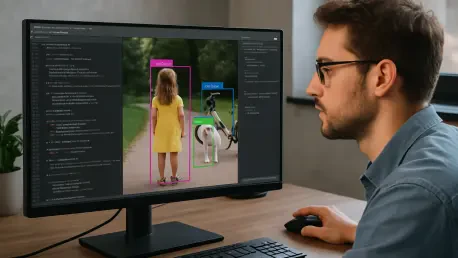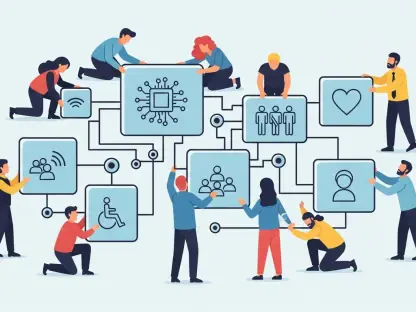Artificial Intelligence (AI) continues to evolve, with cutting-edge models like CoSyn pushing the boundaries of visual understanding. Laurent Giraid, a seasoned technologist specializing in AI and machine learning, delves into how CoSyn is revolutionizing this field by providing an open-source alternative to proprietary giants. Distinctively tackling challenges such as data scarcity and copyright issues, CoSyn offers groundbreaking solutions for diverse industries.
Can you explain what CoSyn is and how it differs from other AI models like GPT-4V and Gemini 1.5 Flash?
CoSyn is an open-source tool that empowers AI systems with advanced visual understanding capabilities. Unlike proprietary models such as GPT-4V and Gemini 1.5 Flash, which are shrouded in secrecy regarding their training methods and data sources, CoSyn is built on transparency and accessibility. It utilizes a unique method to generate synthetic training data, which enables it to match or even surpass these proprietary models in visual tasks without the need for vast financial resources.
What inspired the development of CoSyn, and how does it solve the issue of training data scarcity for visual understanding in AI?
CoSyn was developed in response to the critical need for high-quality training data, particularly for complex visual information like scientific charts and financial documents. Inspired by the idea that many text-rich images are initially created through coding, the researchers designed a system to reverse-engineer this process. By doing so, CoSyn generates synthetic data that fulfills the need for diverse and ethically safe training datasets.
How does CoSyn generate synthetic training data, and why is this approach more efficient than traditional methods?
CoSyn employs language models with robust coding capabilities to generate the underlying code for creating synthetic images. This reverse-engineering method is highly efficient compared to traditional data collection methods, as it bypasses the challenges and legal issues associated with scraping real images from the internet. This allows for quick and scalable generation of high-quality training datasets.
Can you describe the persona-driven mechanism used by CoSyn to enhance data diversity? How does this work in practice?
The persona-driven mechanism is a fascinating feature of CoSyn. By assigning a randomly sampled persona to each generated example, ranging from a sci-fi novelist to a chemistry teacher, CoSyn ensures a wide variety of content and styles in its synthetic data outputs. This approach brings diversity to the generated datasets, allowing AI models to learn from a broad range of scenarios and perspectives.
What are some specific benchmarks where CoSyn-trained models have outperformed proprietary models like GPT-4V and Gemini?
CoSyn-trained models have shown superior performance across several benchmarks, particularly those involving text-rich image understanding. They have outperformed proprietary models like GPT-4V and Gemini in seven benchmark tests. Notably, CoSyn’s models excelled in the NutritionQA benchmark, where they surpassed others in understanding nutrition label photographs, demonstrating the effectiveness of synthetic data.
Can you detail the NutritionQA benchmark and explain why CoSyn’s model performed better than others trained on real images?
The NutritionQA benchmark consists of questions that test a model’s ability to interpret nutrition photographs. CoSyn’s model, trained on synthetically generated labels, outperformed models that relied on real images. This success highlights the efficiency of CoSyn’s synthetic data, which avoids the constraints of data diversity and annotation challenges that come with real-world images.
How is CoSyn finding application in real-world industries, and can you provide examples of companies utilizing this technology?
CoSyn is making significant strides in various industries, offering capabilities in quality assurance and workflow automation. For example, a company involved in cable installation uses CoSyn-enabled models to ensure quality control by analyzing photographs of installation processes. This use case exemplifies CoSyn’s potential in automating and improving efficiency within enterprise settings.
What implications does synthetic data generation have on enterprise AI data strategies, especially in regards to copyright and cost?
The generation of synthetic data fundamentally shifts how enterprises can approach AI data strategies. It eliminates the extensive costs and legal risks associated with collecting and annotating real-world data. Furthermore, it offers a sustainable solution to avoid copyright issues, allowing companies to innovate without infringing on intellectual property rights.
In what ways does CoSyn offer a competitive edge for open-source AI relative to the proprietary models from major tech companies?
CoSyn empowers the open-source community by providing high-quality, accessible AI tools that do not require immense financial backing. This transparency allows researchers and developers worldwide to build on the tools and datasets publicly available, leveling the competitive field against proprietary tech companies that hold significant resources and often obscure methodologies.
What steps were taken to ensure the accessibility and transparency of CoSyn for researchers and companies worldwide?
The researchers behind CoSyn have made a committed effort to ensure full accessibility and transparency. By openly releasing the CoSyn codebase, the synthetic datasets, and all training scripts, they have created a comprehensive resource for the global community. This open approach facilitates collaboration, innovation, and accountability, addressing concerns about the black-box nature of proprietary systems.
Are there limitations to synthetic data generation? How does CoSyn address or plan to address these challenges?
Synthetic data generation does have certain limitations, such as potential bias from the models generating the data and the challenge of creating data with sufficient diversity. CoSyn addresses these by incorporating diverse personas in its data generation process, although developing strategies for overcoming data homogeneity and expanding into areas like medical imaging remains a work in progress.
Can you explain the significance of synthetic “pointing data” in developing AI agents and its potential impact on web-based automation?
Synthetic “pointing data” is crucial for developing AI agents capable of interacting with digital interfaces. By training models to understand where to interact with a screen, based on synthetic data, these agents can execute complex tasks autonomously. This capability allows for more advanced applications in web-based automation, paving the way for systems that can perform operations traditionally requiring human intervention.
How does CoSyn approach training data for natural images, and what future developments are anticipated in this area?
Currently, generating synthetic data for natural images remains a challenge due to the complexity and variability of real-world scenes. While CoSyn excels in generating text-rich synthetic images, ongoing advancements aim to enhance its capability to produce more realistic natural imagery. Future developments will likely include incorporating real-world data into training to create more comprehensive datasets for diverse applications.
What is the role and importance of combining synthetic and real-world data in AI training and model development?
Combining synthetic with real-world data can help address the limitations inherent in each method. While real-world data provides authenticity and natural diversity, synthetic data supplements this with large volumes of varied examples that are free from ethical and legal constraints. This hybrid approach can enhance model robustness and performance, making AI systems both efficient and ethically responsible.
What potential applications do you foresee for CoSyn in assisting people with disabilities or those requiring specialized visual understanding?
CoSyn holds great promise for supporting people with disabilities. One possibility is developing AI systems capable of understanding and interpreting sign language to assist those with hearing impairments. Additionally, it could help create models that are better equipped to explain visual information, such as images or charts, to individuals with visual impairments, improving accessibility across various domains.
How do you envision synthetic data impacting robotics and scientific discovery in the future?
Looking ahead, synthetic data can significantly accelerate advancements in robotics and scientific discovery. For robotics, the ability to generate custom, high-quality training data means that robots can be better prepared for diverse and complex real-world tasks without relying on impractically large datasets. In scientific research, it can simulate scenarios where real-world data is unavailable, difficult, or dangerous to obtain, opening new possibilities for innovation and discovery in fields like medicine and environmental science.
Why did you decide to work with the Allen Institute instead of larger tech companies, and what is your vision for the future of multimodal AI models?
Working with the Allen Institute provided an environment that valued open science and collaboration, which is crucial for advancing AI research. Our goal is to foster an environment where the development of multimodal AI models is accessible, scalable, and transparent. We believe this open-source approach can match the achievements of well-funded proprietary counterparts and create a more equitable AI future.
What broader message does CoSyn’s success send about the potential of open-source AI development compared to proprietary efforts?
CoSyn demonstrates that open-source AI can not only keep pace with proprietary technology but, in many cases, surpass it. This success shows that with innovative approaches and collaborative effort, the open-source community can drive significant advancements in AI. It suggests a future where open-source models offer viable, competitive alternatives to the secretive and resource-intensive solutions from private companies.
Do you have any advice for our readers?
Embrace the spirit of open-source collaboration. Whether you’re an independent researcher or part of an organization, work on projects that value transparency, sharing, and community contribution. It’s through collective efforts that we’ll overcome the significant hurdles in AI development and unlock new potential for technology to make meaningful impacts in diverse fields. Stay curious, collaborate, and don’t hesitate to explore new methods, because the solutions to the challenges we face today might just lie outside the conventional approaches we are used to.









